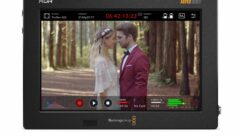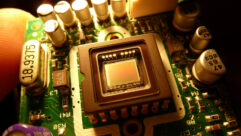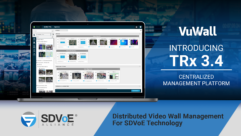
Picture This: What About Video?
May 1, 2004 12:00 PM,
By Jeff Sauer
NEC HT1100
Although it’s not inherently true, a lot of people tend to view the NSCA Systems Integration Expo as more of an audio show than a video show. It’s an infrastructure show primarily, of course, with routers, switches, and cables for both video and audio, but audio reinforcement has had a longer, broader history at the contractor installation level for meeting and conference room installations than video. So the perspective is not surprising.
Visual devices going back to overhead projectors were often more likely to be moved into a space on an as-needed basis than integrated into central systems, or they required relatively minimal cabling compared with audio. Video integration is changing, however, as video projectors, videoconferencing, and video-on-demand network appliances become standard fare in today’s business, educational, and governmental communications.
Because of that, the NSCA Expo offers each year an increasing purview of video-processing equipment from well-known companies such as Extron, Folsom Research, FSR, and TV One. Video infrastructure products could and should become even more important as control of those video devices moves from handheld IR remote and local serial control toward IP-based central control of A/V devices (see the Technology Showcase about IP on p. 62).
Sharp LCM-3700P

Still, a fairly limited number of display and video-specific manufacturers exhibit at NSCA Expo, and fewer still make major announcements there. The show falls within a month before NAB, the video production and broadcast industry’s biggest show, and just a couple of months before InfoComm, the annual focus for the display and A/V communications industries. With those circle-on-the-calendar exhibitions impending, video-oriented manufacturers almost invariably save their big news for the big stages. So how does NSCA Expo fare with video products?
GET THE PICTURE?
At NSCA Expo in March, there were some new video products being shown for the first time, at least the first time for this industry. The NEC Visual Systems HT1100, for example, is a home-theater projector that probably wouldn’t be a focus at NAB or InfoComm. It’s the follow-up version to the successful HT1000, now with a higher (full on/off) contrast ratio of 3500:1 and improved SweetVision II color and contrast enhancement technology. Although the HT1100 is a native 4:3 projector (in the interest of affordability: $4,795), NEC announced that for just an additional $200, it will bundle an anamorphic lens for true 16:9 movie viewing.
Sharp unveiled its LC-M3700P 37-inch LCD monitor that incorporates an antiglare, low-reflective protective overlay for use in high-traffic public display areas. Elmo’s newest HV-5100XG document camera has features like 20 fps, 36x magnification, one-push autofocus, noise-reduction modes for text, 1034-by-779 resolution, and several presentation enhancements and effects. It’s a nice value at a street price of $3,495. In addition, Hall Research had several new and relatively new self-described “niche products that work.” For example, the $595 TVB-350 is a video scaler/up-converter to SXGA or HDTV with time base correction. The $149 CVS-3 is a composite or S-video 1-to-3 video splitter. Finally, the $495 U97-A is a KVM extender over Cat-5 with audio.
Somewhat more on the cutting edge, Sony’s new 802.11 wireless-capable projector was announced a month before the show, though it’s clear the company will have a lot more to talk about come InfoComm in June. Still, the new, roughly 8-pound VPL-CX85 boasts 3000 lumens of brightness and an expected price around $3,700, but more important to the NSCA audience should be its connectivity — including 802.11, Ethernet, and memory stick — and remote administration with Sony’s own PJNet software.
That ability to control a projector over IP and through a browser interface isn’t new. But it’s an important trend for systems integrators to watch because it potentially redefines the A/V control infrastructure, introducing new possibilities and opportunities for integrated visual installations. Sony, Epson, InFocus, NEC, Sanyo, Sharp, and others are exploring this remote administration, and it’s an area of new technology that systems integrators must become familiar with. Individual device control from independent manufacturers is, however, generally limited to each company’s own devices. Larger-scale, facility-wide IP network control and remote administration then fall primarily to the traditional control companies: AMX and Crestron, both of which are regulars at NSCA but are waiting to make major news at InfoComm.

Yet with change comes possible opportunities for new companies with solutions built around the smarter devices and general-purpose CPUs. One such company was tucked away in Sharp Electronics’ NSCA booth. QuickLogix, a fairly new company, offers a software-only IP control solution that attempts to free A/V control from proprietary hardware. At NSCA QuickLogix’s NetControl was controlling Sharp LCD monitors and projectors, but it can also control other brands and can run from a central location. If A/V devices have built-in Ethernet like those I mentioned, NetControl communicates with them directly. For serially controlled projectors, NetControl needs only a serial-to-IP converter box, and there are several of those available.
TOO MANY SHOWS?
Network video appliances represent another type of video device that business installation integrators should keep their eyes on. These devices connect directly to existing local and wide area networks, tend to be IP address self-configuring, and have the sole purpose of moving high-quality video from one place to another. They have traditional audio/video input ports for connecting live cameras or other video devices for security, distance learning, and remote business communication and Ethernet output for sending the digitized video and audio over IP.
Sony VPL-CX85

At NSCA Expo 2004, Visionary Solutions showed its new AVN-200. It’s a small black-box appliance for encoding and distributing video and audio as IP data to a similar decode appliance or a computer desktop media player.Visionary Solutions is a nice addition to NSCA because it smartly expands the traditional range of products at the show. VBrick, on the other hand, was not at NSCA 2004, but the company did exhibit at InfoComm 2003’s Streaming Media Pavilion and plans to do the same at InfoComm 2004. That gets back to the basic dilemma for video companies at NSCA. Are there too many shows, and are they too close together?This past February, NSCA, ICIA, and CEDIA jointly produced the Integrated Systems Europe show. The idea of combining two or all three shows domestically is not particularly new. Indeed, it’s likely that many exhibitors would see that as a convenient solution for saving thousands of dollars in travel and floor space expense.However, that’s a different discussion and not one that should be a real concern for integrators looking to stay current. In a way, the more opportunities to learn about new products the better, as long as each of those opportunities stays relevant. Merging trade shows is less important if each show continues to adapt and to offer its respective audience a compelling array of exhibitors, products, and educational sessions.The ICIA has done that aggressively during the past few years with the addition of more training sessions and InfoComm technology pavilions highlighting new and potentially important technologies such as IT and IP networking, streaming media, and videoconferencing. These pavilions have at times seemed limited, even forced, but it’s hard to fault the effort to introduce new ideas to an industry that is clearly in transition.Ultimately for the NSCA Expo, the lack of major video-related announcements doesn’t really matter if it continues to introduce its audience to new products and ideas that help increase business opportunities. Over the years, I’ve attended the largest, the second-largest, and the fourth-largest trades shows Las Vegas hosts annually. Sometimes smaller shows are welcome opportunity to actually talk and learn about what’s useable today rather than just see and gawk at what’s to come.Jeff Sauer writes the “Picture This” column and is a contributing editor for Video Systems. He’s a video producer, an industry consultant, and director of the Desktop Video Group, a video and computer products testing lab in Cambridge, Massachusetts. He can be reached at [email protected].









